Human Life Development: Errors in Therapeutic Communication Analysis
VerifiedAdded on 2023/03/17
|7
|1395
|59
Homework Assignment
AI Summary
This assignment analyzes a video depicting an interaction between a student nurse and a patient to identify and assess errors in therapeutic communication and violations of professional boundaries. The student identifies four key errors: excessive personal involvement and disclosure, behaviors causing patient stress, over-involvement, and lack of empathy. The significance of each error is discussed, highlighting the impact on patient recovery and well-being. The assignment then proposes corrective actions for each error, emphasizing the importance of formal and respectful communication, empathetic responses, and maintaining professional boundaries to foster a therapeutic environment. The focus is on improving the nurse's approach to patient care by adhering to ethical guidelines and promoting effective communication skills.
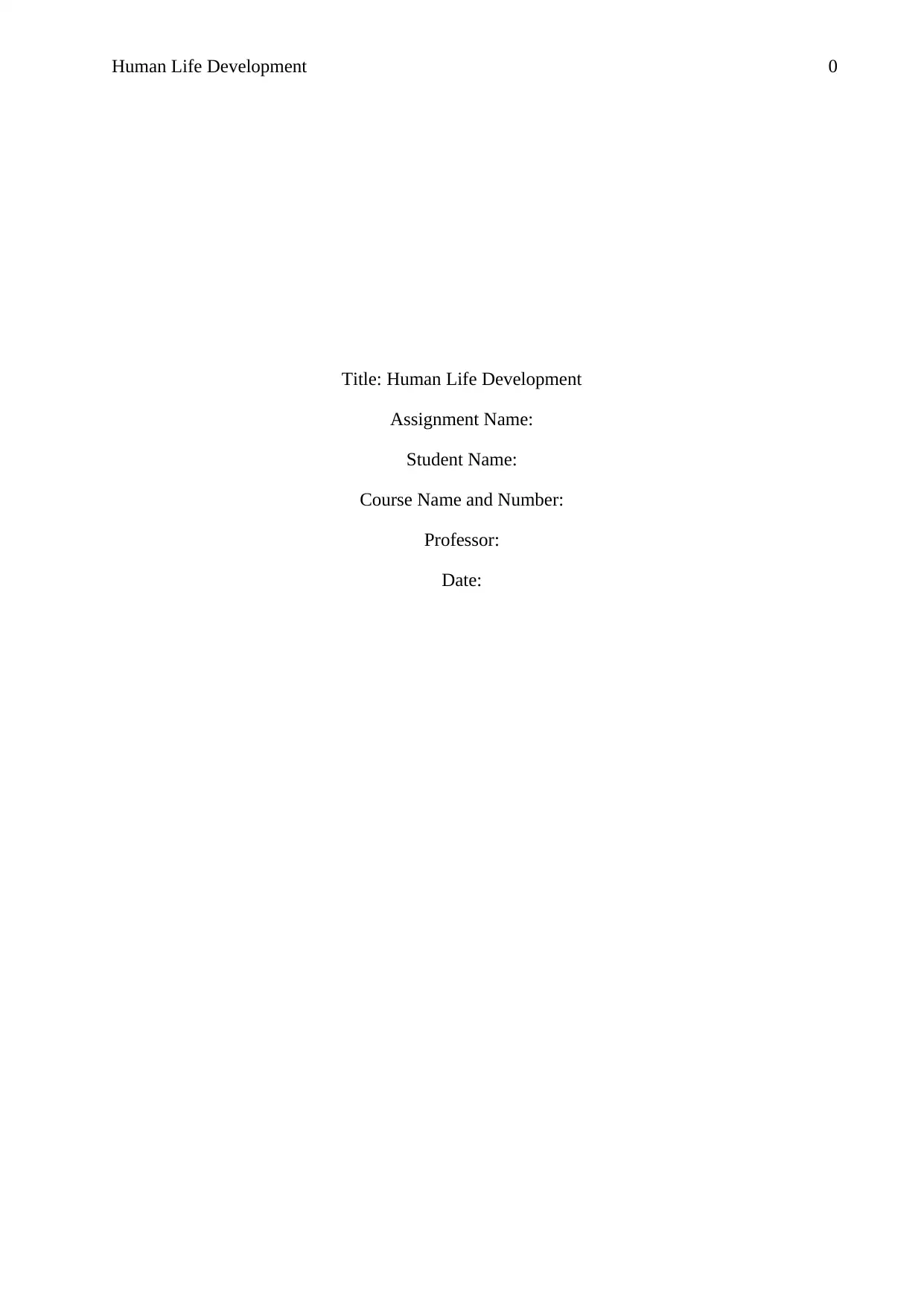
Human Life Development 0
Title: Human Life Development
Assignment Name:
Student Name:
Course Name and Number:
Professor:
Date:
Title: Human Life Development
Assignment Name:
Student Name:
Course Name and Number:
Professor:
Date:
Paraphrase This Document
Need a fresh take? Get an instant paraphrase of this document with our AI Paraphraser
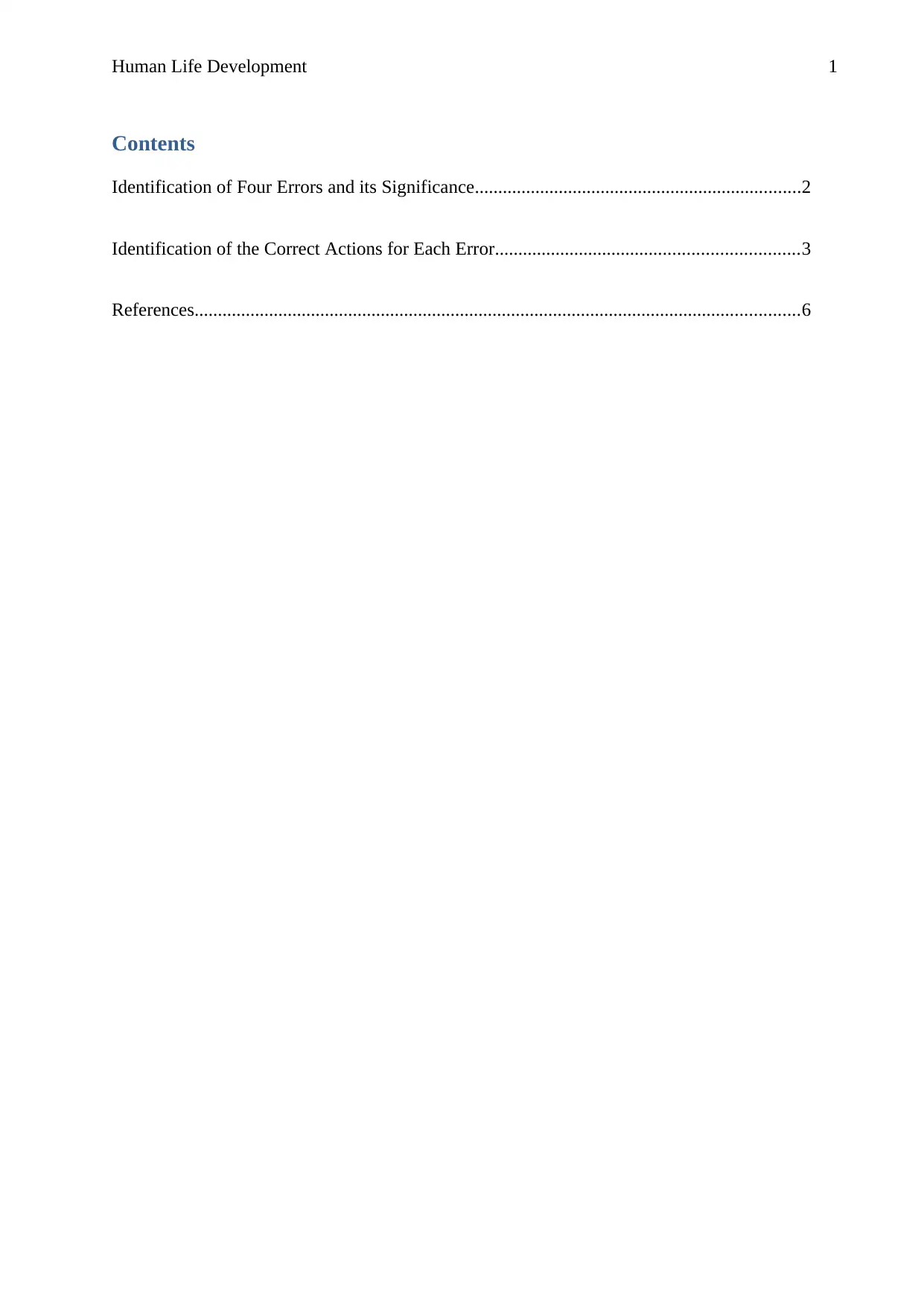
Human Life Development 1
Contents
Identification of Four Errors and its Significance......................................................................2
Identification of the Correct Actions for Each Error.................................................................3
References..................................................................................................................................6
Contents
Identification of Four Errors and its Significance......................................................................2
Identification of the Correct Actions for Each Error.................................................................3
References..................................................................................................................................6
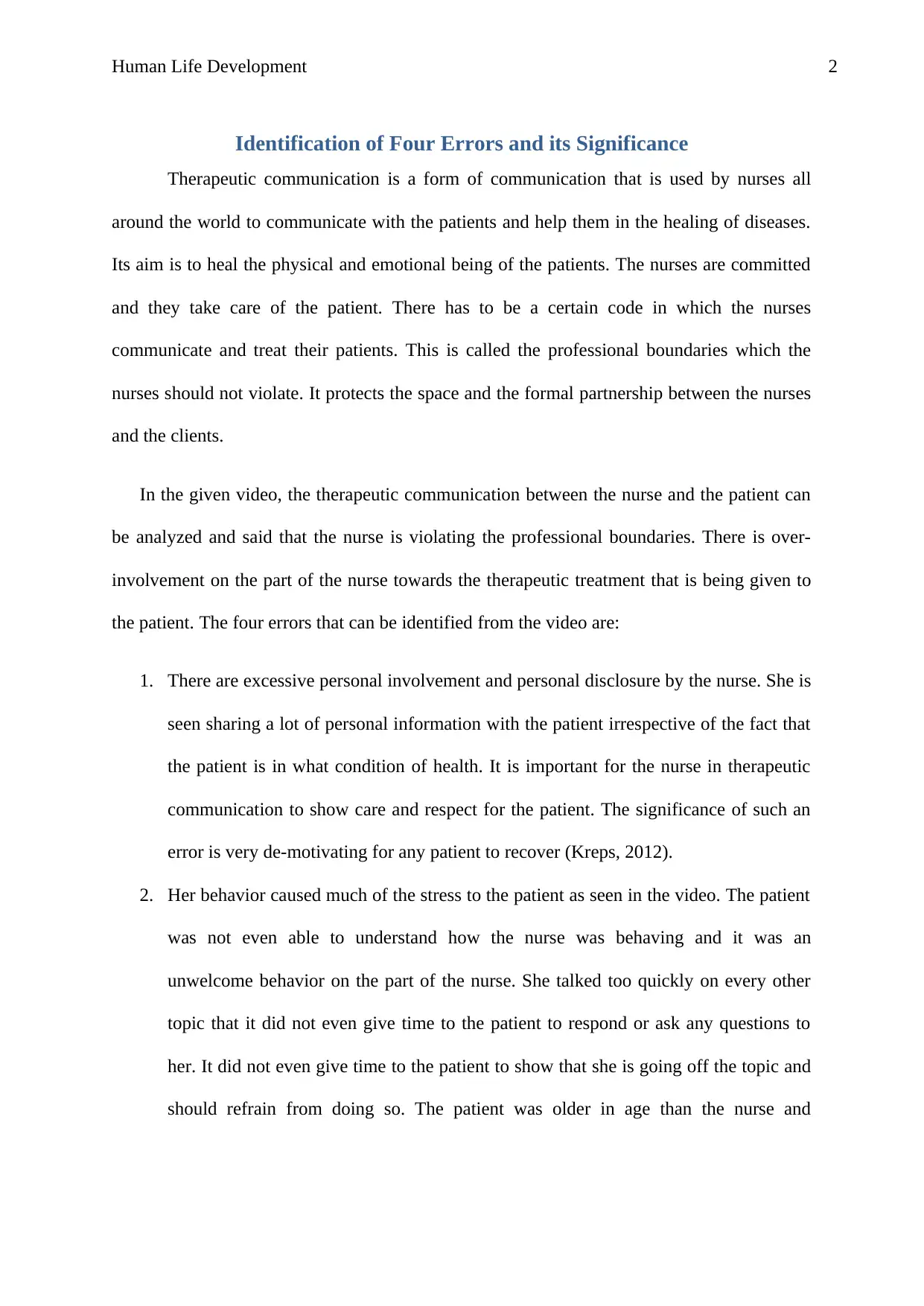
Human Life Development 2
Identification of Four Errors and its Significance
Therapeutic communication is a form of communication that is used by nurses all
around the world to communicate with the patients and help them in the healing of diseases.
Its aim is to heal the physical and emotional being of the patients. The nurses are committed
and they take care of the patient. There has to be a certain code in which the nurses
communicate and treat their patients. This is called the professional boundaries which the
nurses should not violate. It protects the space and the formal partnership between the nurses
and the clients.
In the given video, the therapeutic communication between the nurse and the patient can
be analyzed and said that the nurse is violating the professional boundaries. There is over-
involvement on the part of the nurse towards the therapeutic treatment that is being given to
the patient. The four errors that can be identified from the video are:
1. There are excessive personal involvement and personal disclosure by the nurse. She is
seen sharing a lot of personal information with the patient irrespective of the fact that
the patient is in what condition of health. It is important for the nurse in therapeutic
communication to show care and respect for the patient. The significance of such an
error is very de-motivating for any patient to recover (Kreps, 2012).
2. Her behavior caused much of the stress to the patient as seen in the video. The patient
was not even able to understand how the nurse was behaving and it was an
unwelcome behavior on the part of the nurse. She talked too quickly on every other
topic that it did not even give time to the patient to respond or ask any questions to
her. It did not even give time to the patient to show that she is going off the topic and
should refrain from doing so. The patient was older in age than the nurse and
Identification of Four Errors and its Significance
Therapeutic communication is a form of communication that is used by nurses all
around the world to communicate with the patients and help them in the healing of diseases.
Its aim is to heal the physical and emotional being of the patients. The nurses are committed
and they take care of the patient. There has to be a certain code in which the nurses
communicate and treat their patients. This is called the professional boundaries which the
nurses should not violate. It protects the space and the formal partnership between the nurses
and the clients.
In the given video, the therapeutic communication between the nurse and the patient can
be analyzed and said that the nurse is violating the professional boundaries. There is over-
involvement on the part of the nurse towards the therapeutic treatment that is being given to
the patient. The four errors that can be identified from the video are:
1. There are excessive personal involvement and personal disclosure by the nurse. She is
seen sharing a lot of personal information with the patient irrespective of the fact that
the patient is in what condition of health. It is important for the nurse in therapeutic
communication to show care and respect for the patient. The significance of such an
error is very de-motivating for any patient to recover (Kreps, 2012).
2. Her behavior caused much of the stress to the patient as seen in the video. The patient
was not even able to understand how the nurse was behaving and it was an
unwelcome behavior on the part of the nurse. She talked too quickly on every other
topic that it did not even give time to the patient to respond or ask any questions to
her. It did not even give time to the patient to show that she is going off the topic and
should refrain from doing so. The patient was older in age than the nurse and
⊘ This is a preview!⊘
Do you want full access?
Subscribe today to unlock all pages.

Trusted by 1+ million students worldwide

Human Life Development 3
therefore the nurse could have been a little empathetic in the way she should have
conducted herself.
3. The nurse showed over involvement with the patient, which is a boundary violation of
therapeutic communication. She shared her last night party details and also how she
made a friend and got a new cell phone which was not required to be discussed with
her patient. The nurse was very casual in her approach while comforting the patient
and the way she behaved with her made the patient stressed (Pasquier and Fivat,
2012).
4. She did not show any sign of being empathetic with her patient. She tried to comfort
her patient by saying that many people have such problems and there is nothing
serious that has to undergo for her health condition. She should have comforted her by
saying that she should not get stressed with the procedure of medical treatment
because she will have a healthy recovery soon (Norman and Eva, 2010).
The four mistakes that are identified in the video interaction show that there has to be a
boundary beyond which no nurse should conduct herself. Therefore, the whole purpose of
therapeutic communication failed to do what it is aimed at.
Identification of the Correct Actions for Each Error
Therapeutic communication is an essential part of providing healthcare services to
patients. Therefore, every effort should be made by the nurses to avoid any such mistake
which violates or crosses the professional boundary of the communication. The four errors
that are identified above can have corrective measures. The nurse should have taken these
corrective actions:
1. The nurse should have been formal in her approach to the patient. Since the patient
was old aged, she should have shown some respect to her by conducting herself in a
therefore the nurse could have been a little empathetic in the way she should have
conducted herself.
3. The nurse showed over involvement with the patient, which is a boundary violation of
therapeutic communication. She shared her last night party details and also how she
made a friend and got a new cell phone which was not required to be discussed with
her patient. The nurse was very casual in her approach while comforting the patient
and the way she behaved with her made the patient stressed (Pasquier and Fivat,
2012).
4. She did not show any sign of being empathetic with her patient. She tried to comfort
her patient by saying that many people have such problems and there is nothing
serious that has to undergo for her health condition. She should have comforted her by
saying that she should not get stressed with the procedure of medical treatment
because she will have a healthy recovery soon (Norman and Eva, 2010).
The four mistakes that are identified in the video interaction show that there has to be a
boundary beyond which no nurse should conduct herself. Therefore, the whole purpose of
therapeutic communication failed to do what it is aimed at.
Identification of the Correct Actions for Each Error
Therapeutic communication is an essential part of providing healthcare services to
patients. Therefore, every effort should be made by the nurses to avoid any such mistake
which violates or crosses the professional boundary of the communication. The four errors
that are identified above can have corrective measures. The nurse should have taken these
corrective actions:
1. The nurse should have been formal in her approach to the patient. Since the patient
was old aged, she should have shown some respect to her by conducting herself in a
Paraphrase This Document
Need a fresh take? Get an instant paraphrase of this document with our AI Paraphraser

Human Life Development 4
way that would have shown some responsible behavior on her part. She started
sharing an informal conversation which was not required at that place (Younis,
Mabrouk and Kamal, 2015).
2. The way she was talking caused stress in the patient, which was reflected on her face
and the way she was sitting. The nurse failed to read her expressions to refrain herself
from doing things which she was doing. She should have talked politely and decently
with her patient and should have given time to her to respond to her and ask any
further questions (Levett-Jones, 2017).
3. She was very casual regarding the health of the patient and she was being very
informal while dealing with her patient. She should have been a bit responsible and
disciplined in her behavior. She shared her last night details with the patient, which
got nothing to do with the framework in which she was communicating. It did not
have any relevance at that place. She justified her irresponsible behavior by sharing
her personal information with the patient (Avery, 2010).
4. The most important part of the therapeutic communication is being empathetic and
speaks less so that it gives a chance for the patient to ask any questions and for the
nurse to understand the state of the patient and help in the healthy recovery of the
patient. Whereas in such a situation, it failed. The nurse was not able to deliver any of
these essential elements in her form of communication. Neither she took the medical
condition of her patient seriously, nor did she show any sign of being empathetic with
her patient (Ishmael and Manley, 2011). She should have comforted the patient by
saying that she should be free of stress as the medical procedure which she has to
undergo is just a part of the medical treatment and she would be absolutely healthy
and fine again soon.
way that would have shown some responsible behavior on her part. She started
sharing an informal conversation which was not required at that place (Younis,
Mabrouk and Kamal, 2015).
2. The way she was talking caused stress in the patient, which was reflected on her face
and the way she was sitting. The nurse failed to read her expressions to refrain herself
from doing things which she was doing. She should have talked politely and decently
with her patient and should have given time to her to respond to her and ask any
further questions (Levett-Jones, 2017).
3. She was very casual regarding the health of the patient and she was being very
informal while dealing with her patient. She should have been a bit responsible and
disciplined in her behavior. She shared her last night details with the patient, which
got nothing to do with the framework in which she was communicating. It did not
have any relevance at that place. She justified her irresponsible behavior by sharing
her personal information with the patient (Avery, 2010).
4. The most important part of the therapeutic communication is being empathetic and
speaks less so that it gives a chance for the patient to ask any questions and for the
nurse to understand the state of the patient and help in the healthy recovery of the
patient. Whereas in such a situation, it failed. The nurse was not able to deliver any of
these essential elements in her form of communication. Neither she took the medical
condition of her patient seriously, nor did she show any sign of being empathetic with
her patient (Ishmael and Manley, 2011). She should have comforted the patient by
saying that she should be free of stress as the medical procedure which she has to
undergo is just a part of the medical treatment and she would be absolutely healthy
and fine again soon.
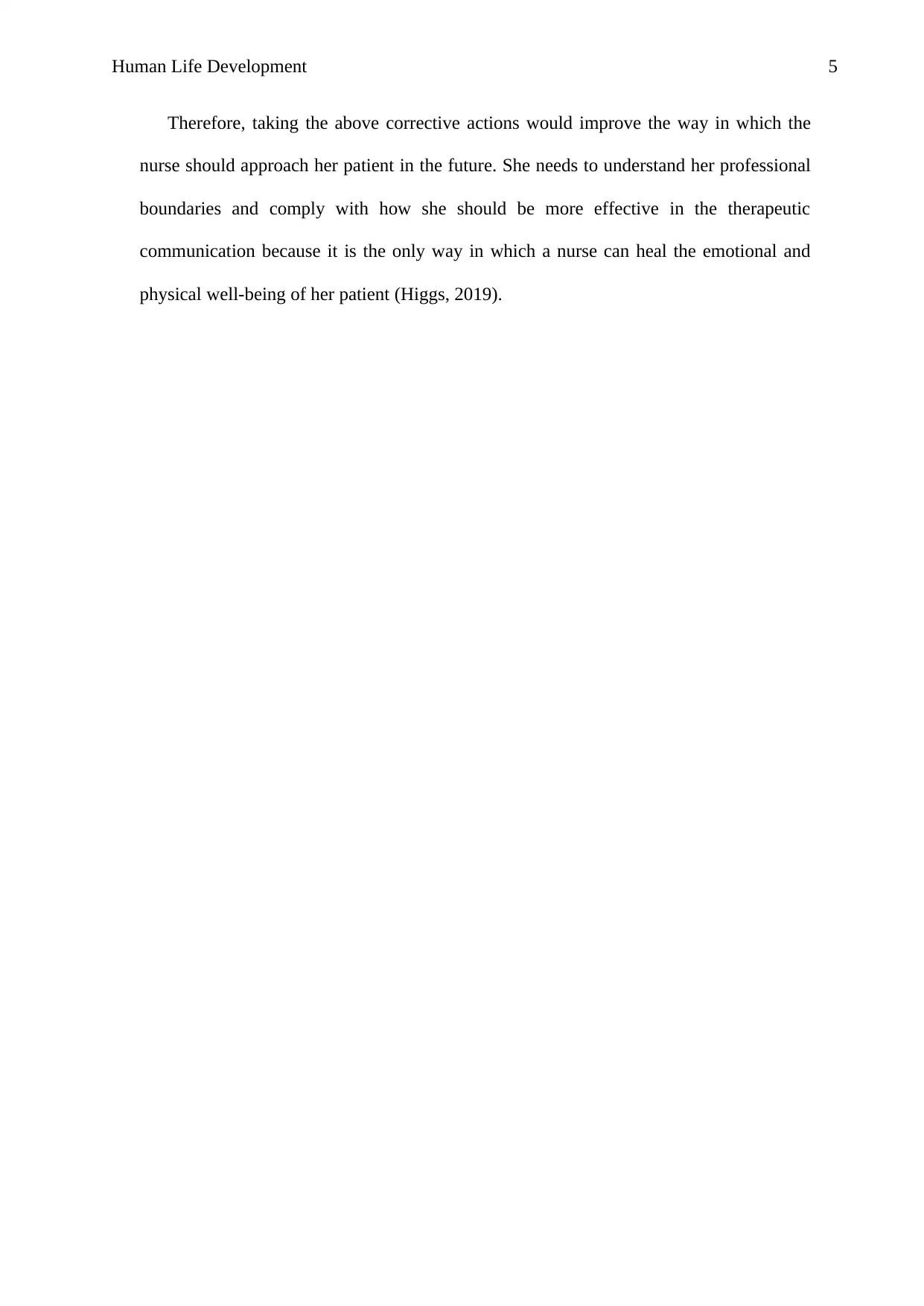
Human Life Development 5
Therefore, taking the above corrective actions would improve the way in which the
nurse should approach her patient in the future. She needs to understand her professional
boundaries and comply with how she should be more effective in the therapeutic
communication because it is the only way in which a nurse can heal the emotional and
physical well-being of her patient (Higgs, 2019).
Therefore, taking the above corrective actions would improve the way in which the
nurse should approach her patient in the future. She needs to understand her professional
boundaries and comply with how she should be more effective in the therapeutic
communication because it is the only way in which a nurse can heal the emotional and
physical well-being of her patient (Higgs, 2019).
⊘ This is a preview!⊘
Do you want full access?
Subscribe today to unlock all pages.

Trusted by 1+ million students worldwide
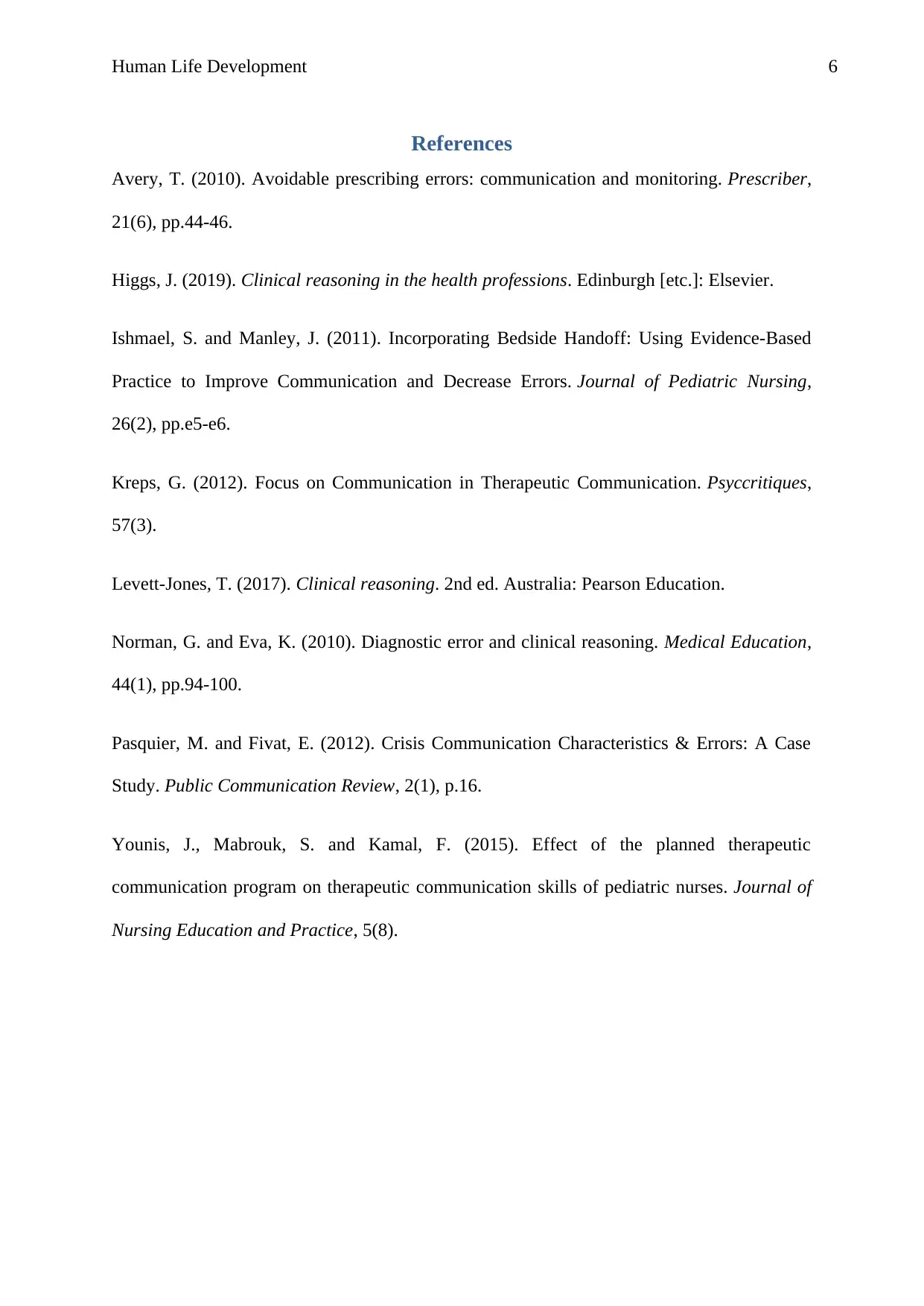
Human Life Development 6
References
Avery, T. (2010). Avoidable prescribing errors: communication and monitoring. Prescriber,
21(6), pp.44-46.
Higgs, J. (2019). Clinical reasoning in the health professions. Edinburgh [etc.]: Elsevier.
Ishmael, S. and Manley, J. (2011). Incorporating Bedside Handoff: Using Evidence-Based
Practice to Improve Communication and Decrease Errors. Journal of Pediatric Nursing,
26(2), pp.e5-e6.
Kreps, G. (2012). Focus on Communication in Therapeutic Communication. Psyccritiques,
57(3).
Levett-Jones, T. (2017). Clinical reasoning. 2nd ed. Australia: Pearson Education.
Norman, G. and Eva, K. (2010). Diagnostic error and clinical reasoning. Medical Education,
44(1), pp.94-100.
Pasquier, M. and Fivat, E. (2012). Crisis Communication Characteristics & Errors: A Case
Study. Public Communication Review, 2(1), p.16.
Younis, J., Mabrouk, S. and Kamal, F. (2015). Effect of the planned therapeutic
communication program on therapeutic communication skills of pediatric nurses. Journal of
Nursing Education and Practice, 5(8).
References
Avery, T. (2010). Avoidable prescribing errors: communication and monitoring. Prescriber,
21(6), pp.44-46.
Higgs, J. (2019). Clinical reasoning in the health professions. Edinburgh [etc.]: Elsevier.
Ishmael, S. and Manley, J. (2011). Incorporating Bedside Handoff: Using Evidence-Based
Practice to Improve Communication and Decrease Errors. Journal of Pediatric Nursing,
26(2), pp.e5-e6.
Kreps, G. (2012). Focus on Communication in Therapeutic Communication. Psyccritiques,
57(3).
Levett-Jones, T. (2017). Clinical reasoning. 2nd ed. Australia: Pearson Education.
Norman, G. and Eva, K. (2010). Diagnostic error and clinical reasoning. Medical Education,
44(1), pp.94-100.
Pasquier, M. and Fivat, E. (2012). Crisis Communication Characteristics & Errors: A Case
Study. Public Communication Review, 2(1), p.16.
Younis, J., Mabrouk, S. and Kamal, F. (2015). Effect of the planned therapeutic
communication program on therapeutic communication skills of pediatric nurses. Journal of
Nursing Education and Practice, 5(8).
1 out of 7
Related Documents
Your All-in-One AI-Powered Toolkit for Academic Success.
+13062052269
info@desklib.com
Available 24*7 on WhatsApp / Email
![[object Object]](/_next/static/media/star-bottom.7253800d.svg)
Unlock your academic potential
Copyright © 2020–2025 A2Z Services. All Rights Reserved. Developed and managed by ZUCOL.




